| Activities
and Events near Copacabana |
| Day
5 |
| SouthWind quote |
| |
Rising early, we'll depart the
city in a private vehicle for a 1½ hour drive along the Yampupata peninsula.
Along the way we can enjoy the region's lovely landscapes as we pass small
adobe fishing settlements like Titikachi which being located on sapphire
blue bays with sandy white beaches remind some travelers of the Greek coast.
We might have a chance to visit with the shepherds who live in the tiny
hamlets we pass, and we may see farmers working their fields with teams
of oxen or hand tools or, depending on the time of year, watch as they harvest
their crops of potatoes, barley, wheat, beans, and quinoa. We'll marvel
at exquisite views of the lake, and possibly take a short journey in an
authentic totora boat near the town of Sikuani. Arriving to
the point of the peninsula, near the community of Yampupata, we'll
embark in a small, partially covered motorboat (accommodating approximately
8-10 participants) for the 20-minute excursion across Lake Titicaca to the
southeastern side of the sacred Island of the Sun. Upon reaching
the island, we'll ascend a steep staircase from the boat dock and walk through
the two-storied ruins of Pilko kaina. Afterwards we'll hike about
30 minutes along ancient terraces which are still in use by the local farmers
before encountering a eucalyptus glade and the enigmatic Inca's Fountain.
This seems to have originally been a Tiahuanacan structure but shows later
Incan influences. After exploring this site, whose running waters are supposed
to infer a blessing upon those who visit, we'll have a picnic lunch and
board our motor launch to head back across the lake to Copacabana
(about 2½ hours). From the docks we'll walk back to the familiar Rosario
del Lago Hotel (or similar) and enjoy dinner together later this evening. (CB,L,D) |
| email
home from Copacabana |
| |
In Copacabana we drove on a dirt road to the end of a pensiula to take
a small fishing boat to the Island of the Sun in Lake Titicaca. On the
way we stopped at a family`s home and took a short ride in a tortora reed
boat. He had a honda (incan sling shot) around his neck, so I asked for
a demonstation and explained that my father played with one of those as
a kid. He shot two different rocks about 200 yards into the lake. For
20 Bols. ($3) we now own one. On the island we visited Inca ruins of the
sun temple and hiked along the Incan terraces still used today to a mountain
spring that decended down hundreds of steps. This water was said to be
the water of life. Back to Copacabana to send the previous email and visit
the Modana in the hugh church in the town square, built on top of an Incan
Temple. We also hike to the top of a promiant peak on the pensula, another
Incan spirital site, replaced with stations of the Cross by the Catholics.
|
|
| |
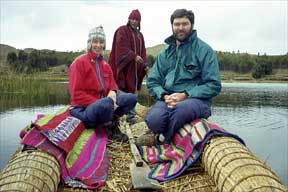 |
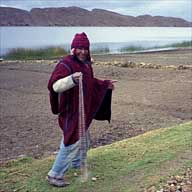
He shot a rock clear into the water. |
|
| |
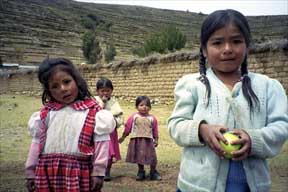
|
We traded our apples for a picture. These
girls were on their way to the water front to play near the boats that were
pulled up onto the beach. |
|
and |
| |
According to legend, the Inca Empire
was founded on these Islands when a golden rod was brought to earth by Manco
Kapac and Mama Ocilo, son and daughter of the Sun God-Inti and was buried
there. There are several ruins on both islands supporting this legend. On
the Island of the Sun, we visit the Inca Staircase and the Inca Springs,
said to be a source of eternal youth and happiness. Enjoy a breathtaking
view of the lake, the Royal Range of the Andes and pre-Colombian Inca terraces
still farmed by local natives. According to an ancient tradition, upon returning
on board, all passengers are blessed with sacred water, receive a crossing
certificate, and a Bolivian drink. |
| |
The Island of the Sun was known to early inhabitants
as Titicaca of "Rock of the Puma", the name which was eventually given to
the entire lake. The island has been credited as the birthplace of all sorts
of important entities, including the Sun itself. But the most important
and enduring legend is that it was here that Father Sun summoned Manco Kapac
and Mama Ocllo and sent them forth to gather the natives into communities
and to teach them the arts of civilization and this was born the Inca Empire.
The island remains today one of the most sacred and spiritual of sites in
the Andes. |
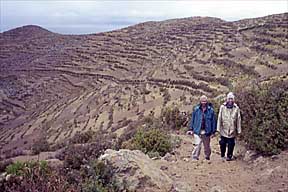 |
| |
One legend expands the legend of creation, pinpointing
the Sacred Rock at Chinkana as the site. At the far northern end of the
Island, Chinkana has some restored temples and nunnery. You can trek there
and back or go by boat, hike uphill to the ruins and trek back. Either way
take along a box lunch and make it a day. The views from Chinkana are impressive
and the site is worth an hour or two. |
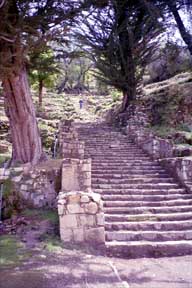 |
| |
Yumani Village on Isla de la Sol |
| |
Lake Titicaca from the Island of the Sun. |
|
|
| |
|
|
| |
Every Sunday in front of the Cathedral a line of cars, trucks,
buses and mini-buses, all decorated with garlands of flowers, wait to be
blessed by the priest for a form of spiritual insurance. The Cathedral was
built between 1610 and 1620 to accommodate the pilgrims who flocked to town.
When miracles began happening in he Sanctuary after the presentation of
a black wooden statue of the Virgin Mary, carved in the later 1570's by
Francisco Yupanqui, grandson of the Inca Tupac Yupanqui. The Virgin is know
both as the Dark Virgin of the Lake or the Virgen de la Candelaria, the
patron saint of Bolivia. The Cathedral has a spacious atrium and four small
chapels. The main chapel has a fine altar and there are 17th and 18th century
paintings and statues in the Sanctuary. |
|
|
| |




